
a)
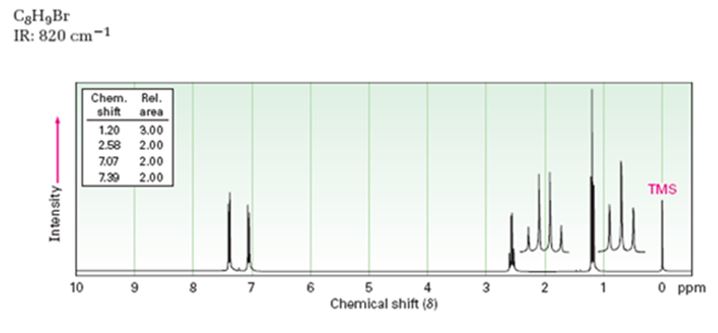
Interpretation:
A structure for the compound whose 1HNMR spectrum given is to be proposed. Given: M.F = C8H9Br I.R: 820 cm-1.
1HNMR spectrum: 7.07δ (2H, doublet); 7.39δ (2H, doublet); 2.58δ (2H, quartet); 1.20δ (3H, triplet).
Concept introduction:
In 1HNMR spectrum
In I.R, the o-disubstituted benzenes absorb around 735-770 cm-1, m-disubstituted benzenes absorb around 690-710 cm-1 and p-disubstituted benzenes absorb around 810-840 cm-1.
To propose:
A structure for the compound whose 1HNMR spectrum given is to be proposed. Given: M.F = C8H9Br I.R: 820 cm-1.
1HNMR spectrum: 7.07δ (2H, doublet); 7.39δ (2H, doublet); 2.58δ (2H, quartet); 1.20δ (3H, triplet).
Answer to Problem 47AP
A structure for the compound with M.F = C8H9Br with spectral characteristics: I.R: 820 cm-1, 1HNMR spectrum: 7.07δ (2H, doublet); 7.39δ (2H, doublet); 2.58δ (2H, quartet); 1.20δ (3H, triplet) is
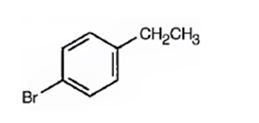
Explanation of Solution
The molecular formula of the compound is C8H9Br.


Thus the compound has four unsaturation units like double bonds and/or rings. The two doublets at 7.07δ and 7.39δ each corresponding to two protons indicate the compound is aromatic and each proton responsible for the doublet has a proton on the adjacent carbon. The two proton quartet at 2.58δ (benzylic) and three proton triplet at 1.20δ (primary) could be accounted for only if an ethyl substituent is present on the ring along with bromine. The I.R absorption at 820 cm-1 indicates that the ethyl group and bromine are arranged in para positions. Hence the compound is p-bromoethyl benzene.
A structure for the compound with M.F=C8H9Br with spectral characteristics: I.R: 820 cm-1, 1HNMR spectrum: 7.07δ (2H, doublet); 7.39δ (2H, doublet); 2.58δ (2H, quartet); 1.20δ (3H, triplet) is

b)
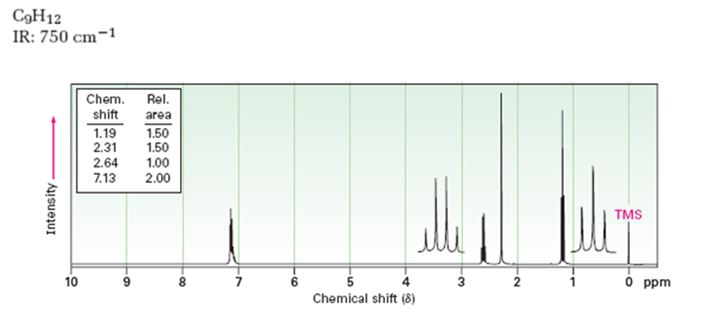
Interpretation:
A structure for the compound whose 1HNMR spectrum given is to be proposed.
Given: M.F = C9H12 I.R: 750 cm-1
1HNMR spectrum: 7.13δ (4H, broad); 2.64δ (2H, quartet); 2.31δ (3H, singlet); 1.19δ (3H, triplet).
Concept introduction:
In 1HNMR spectrum aromatic protons give a broad peak in the range 6.5δ-8.0δ, the primary alkyl protons around 0.7δ-1.3δ, the secondary alkyl protons around 1.2δ-1.6δ, and a tertiary alkyl protons in between 1.4δ-1.8δ. The multiplicity of a signal gives an idea about the protons present in the adjacent carbons.
In I.R, the o-disubstituted benzenes absorb around 735-770 cm-1, m-disubstituted benzenes absorb around 690-710 cm-1and p-disubstituted benzenes absorb around 810-840 cm-1.
To propose:
A structure for the compound whose 1HNMR spectrum given is to be proposed. Given: M.F = C9H12 I.R: 750 cm-1.
1HNMR spectrum: 7.13δ (4H, broad); 2.64δ (2H, quartet); 2.31δ (3H, singlet); 1.19δ (3H, triplet).
Answer to Problem 47AP
A structure for the compound whose 1HNMR spectrum given is to be proposed. Given: M.F = C9H12, I.R: 750 cm-1, 1HNMR spectrum: 7.13δ (4H, broad); 2.64δ (2H, quartet); 2.31δ (3H, singlet); 1.19δ (3H, triplet) is
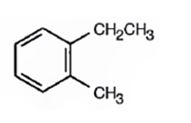
Explanation of Solution
The molecular formula of the compound is C9H12.


Thus the compound has four unsaturation units like double bonds and/or rings. The four proton broad band at 7.13δ indicates that the compound is aromatic with two substituent groups attached to the benzene ring. The two proton quartet at 2.64δ (benzylic) and three proton triplet at 1.19δ (primary alkyl) could be accounted for only if an ethyl group is present on the ring. The three proton singlet at 2.31δ (benzylic) can be attributed to a methyl group attached to the ring. Thus the two substituent groups attached to the benzene ring are ethyl and methyl. The I.R absorption at 750 cm-1 requires that the ethyl and methyl groups to be arranged in ortho positions. Hence the compound is o-ethyltoluene.
A structure for the compound whose 1HNMR spectrum given is to be proposed. Given: M.F = C9H12, I.R: 750 cm-1, 1HNMR spectrum: 7.13δ (4H, broad); 2.64δ (2H, quartet); 2.31δ (3H, singlet); 1.19δ (3H, triplet) is

c)
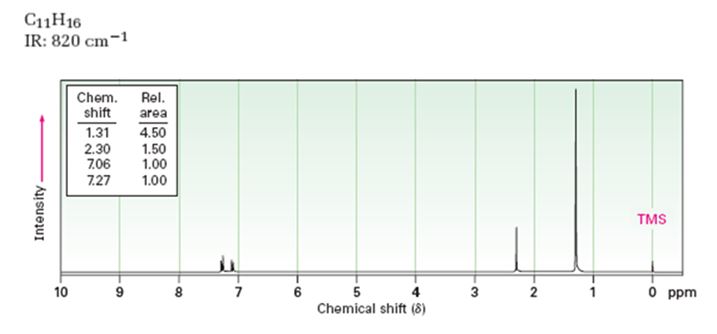
Interpretation:
A structure for the compound whose 1HNMR spectrum given is to be proposed. Given: M.F = C11H16 I.R: 820 cm-1.
1HNMR spectrum: 7.27δ (2H, doublet); 7.06δ (2H, doublet); 2.30δ (3H, singlet); 1.31δ (9H, singlet).
Concept introduction:
In 1HNMR spectrum aromatic protons give a broad peak in the range 6.5δ-8.0δ, the primary alkyl protons around 0.7δ-1.3 δ, the secondary alkyl protons around 1.2δ-1.6δ, and a tertiary alkyl protons in between 1.4δ-1.8δ. The multiplicity of a signal gives an idea about the protons present in the adjacent carbons.
In I.R, the o-disubstituted benzenes absorb around 735-770 cm-1, m-disubstituted benzenes absorb around 690-710 cm-1 and p-disubstituted benzenes absorb around 810-840 cm-1.
To propose:
A structure for the compound whose 1HNMR spectrum given is to be proposed. Given: M.F = C11H16 I.R: 820 cm-1.
1HNMR spectrum: 7.27δ (2H, doublet); 7.06δ (2H, doublet); 2.30δ (3H, singlet); 1.31δ (9H, singlet).
Answer to Problem 47AP
A structure for the compound whose 1HNMR spectrum given is to be proposed. Given: M.F = C11H16; I.R: 820 cm-1; 1HNMR spectrum: 7.27δ (2H, doublet); 7.06δ (2H, doublet); 2.30δ (3H, singlet); 1.31δ (9H, singlet).
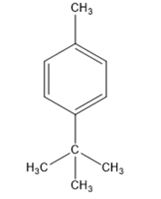
Explanation of Solution
The molecular formula of the compound is C11H16.


Thus the compound has four unsaturation units like double bonds and/or rings. The two doublets at 7.27δ and 7.06δ each corresponding to two protons indicate the compound is aromatic and each proton responsible for the doublet has a proton on the adjacent carbon. The three proton singlet at 2.58δ (benzylic) could be accounted for a methyl group attached to the benzene ring. The remaining four carbons and nine hydrogens indicate the presence of a tert-butyl group attached to the benzene ring which is confirmed by the nine proton singlet at 1.31δ (primary alkyl). Thus methyl and tert-butyl are the two substituent groups on the benzene ring. The I.R absorption at 820 cm-1 indicates that the two substituent groups are arranged in para positions. Hence the compound is p-t-butyltoluene.
A structure for the compound whose 1HNMR spectrum given is to be proposed. Given: M.F = C11H16; I.R: 820 cm-1; 1HNMR spectrum: 7.27δ (2H, doublet); 7.06δ (2H, doublet); 2.30δ (3H, singlet); 1.31δ (9H, singlet).

Want to see more full solutions like this?
Chapter 15 Solutions
OWLv2 with Student Solutions Manual eBook, 4 terms (24 months) Printed Access Card for McMurry's Organic Chemistry, 9th
- 32. Consider a two-state system in which the low energy level is 300 J mol 1 and the higher energy level is 800 J mol 1, and the temperature is 300 K. Find the population of each level. Hint: Pay attention to your units. A. What is the partition function for this system? B. What are the populations of each level? Now instead, consider a system with energy levels of 0 J mol C. Now what is the partition function? D. And what are the populations of the two levels? E. Finally, repeat the second calculation at 500 K. and 500 J mol 1 at 300 K. F. What do you notice about the populations as you increase the temperature? At what temperature would you expect the states to have equal populations?arrow_forward30. We will derive the forms of the molecular partition functions for atoms and molecules shortly in class, but the partition function that describes the translational and rotational motion of a homonuclear diatomic molecule is given by Itrans (V,T) = = 2πmkBT h² V grot (T) 4π²IKBT h² Where h is Planck's constant and I is molecular moment of inertia. The overall partition function is qmolec Qtrans qrot. Find the energy, enthalpy, entropy, and Helmholtz free energy for the translational and rotational modes of 1 mole of oxygen molecules and 1 mole of iodine molecules at 50 K and at 300 K and with a volume of 1 m³. Here is some useful data: Moment of inertia: I2 I 7.46 x 10- 45 kg m² 2 O2 I 1.91 x 101 -46 kg m²arrow_forwardK for each reaction step. Be sure to account for all bond-breaking and bond-making steps. HI HaC Drawing Arrows! H3C OCH3 H 4 59°F Mostly sunny H CH3 HO O CH3 'C' CH3 Select to Add Arrows CH3 1 L H&C. OCH3 H H H H Select to Add Arrows Q Search Problem 30 of 20 H. H3C + :0: H CH3 CH3 20 H2C Undo Reset Done DELLarrow_forward
- Draw the principal organic product of the following reaction.arrow_forwardCurved arrows are used to illustrate the flow of electrons. Using the provided structures, draw the curved arrows that epict the mechanistic steps for the proton transfer between a hydronium ion and a pi bond. Draw any missing organic structures in the empty boxes. Be sure to account for all lone-pairs and charges as well as bond-breaking and bond-making steps. 2 56°F Mostly cloudy F1 Drawing Arrows > Q Search F2 F3 F4 ▷11 H. H : CI: H + Undo Reset Done DELLarrow_forwardCalculate the chemical shifts in 13C and 1H NMR for 4-chloropropiophenone ? Write structure and label hydrogens and carbons. Draw out the benzene ring structure when doing itarrow_forward
- 1) Calculate the longest and shortest wavelengths in the Lyman and Paschen series. 2) Calculate the ionization energy of He* and L2+ ions in their ground states. 3) Calculate the kinetic energy of the electron emitted upon irradiation of a H-atom in ground state by a 50-nm radiation.arrow_forwardCalculate the ionization energy of He+ and Li²+ ions in their ground states. Thannnxxxxx sirrr Ahehehehehejh27278283-4;*; shebehebbw $+$;$-;$-28283773838 hahhehdvaarrow_forwardPlleeaasseee solllveeee question 3 andd thankss sirr, don't solve it by AI plleeaasseee don't use AIarrow_forward
- Calculate the chemical shifts in 13C and 1H NMR for 4-chloropropiophenone ? Write structure and label hydrogens and carbonsarrow_forwardPlease sirrr soollveee these parts pleaseeee and thank youuuuuarrow_forwardPlease sirrr soollveee these parts pleaseeee and thank youuuuu, don't solve it by AI plleeaasseeearrow_forward

 Organic ChemistryChemistryISBN:9781305580350Author:William H. Brown, Brent L. Iverson, Eric Anslyn, Christopher S. FootePublisher:Cengage Learning
Organic ChemistryChemistryISBN:9781305580350Author:William H. Brown, Brent L. Iverson, Eric Anslyn, Christopher S. FootePublisher:Cengage Learning

